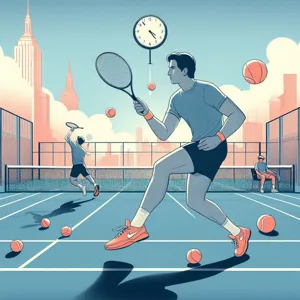Tennis is a game of precision, agility, and strategy, where every stroke can make or break a point.
Among the various skills that define a successful player, mastering the volley return stands out as a crucial element that can elevate your game to new heights. Whether you’re a weekend warrior or an aspiring pro, understanding how to effectively handle volleys can give you a significant advantage on the court. In this guide, we’ll explore top strategies for improving your volley returns, from mastering footwork and positioning to honing your reflexes and shot selection. With practical tips and expert insights, you’ll learn how to turn those challenging volleys into opportunities, giving you the confidence to dominate at the net. So grab your racket, and let’s dive into the art of volley returns that will leave your opponents scrambling!
1. Understanding the Importance of Volley Returns

In the fast-paced world of tennis, mastering your volley returns can be the difference between winning and losing a match. While many players focus on perfecting their serves or groundstrokes, the volley return is often overlooked, yet it holds immense significance in dictating the flow of a game. A well-executed volley not only allows you to capitalize on your opponent’s weaknesses but also puts you in a commanding position on the court.
Understanding the importance of volley returns begins with recognizing their strategic impact. When your opponent approaches the net, they may feel confident, but a strong volley return can disrupt their rhythm and create opportunities for you to take control of the point. It’s about playing a psychological game as much as a physical one; a powerful return can instill doubt in your opponent’s mind and force them to rethink their approach.
Additionally, volley returns are critical in doubles play, where the dynamics shift dramatically. In this scenario, effective volley returns can help set the tone for your team’s positioning and create openings for decisive plays. They enable you to quickly shift from defense to offense, allowing you to put pressure on your opponents and capitalize on any hesitation.
Moreover, developing solid volley returns contributes to your overall game strategy. The more proficient you become at reading your opponent’s shots and anticipating their moves, the more effective your returns will be. This skill not only enhances your volleying technique but also improves your court awareness, enabling you to respond more adeptly to various playing styles.
In summary, mastering volley returns is essential for elevating your game. By dedicating time to understanding their significance and honing your skills, you can transform this often-overlooked aspect of tennis into one of your greatest assets on the court. Whether you’re a singles player looking to outmaneuver your opponent or a doubles competitor aiming to dominate the net, focusing on your volley returns will undoubtedly enhance your overall performance and increase your chances of victory.
2. Analyzing the Different Types of Volleys
When it comes to mastering your volley returns, understanding the different types of volleys is crucial. Each volley serves a unique purpose and can dramatically influence your position on the court and the outcome of the point. Let’s break down the primary types of volleys you might encounter or need to execute during a match.
**1. Forehand Volley:** This is typically the most natural volley for right-handed players, as it’s a continuation of the forehand groundstroke. To execute an effective forehand volley, focus on stepping into the shot, using a compact swing, and keeping your paddle face slightly open. This will help you control the ball’s direction and give it a firm punch.
**2. Backhand Volley:** The backhand volley can often feel less intuitive, but with practice, it can become a powerful tool in your arsenal. Position yourself well, using your non-dominant hand to guide the racket and your body to generate momentum. A solid backhand volley can catch your opponent off guard, especially when hit with depth or angle.
**3. High Volley:** Often seen in doubles play, the high volley is executed when the ball is at or above your shoulder height. Timing is critical here; you want to connect with the ball at its peak to maintain control and ensure you can place it accurately. High volleys can be aggressive, allowing you to dictate the pace and pressure your opponents.
**4. Drop Volley:** This delicate shot can be a game-changer, especially when you’re looking to catch your opponent off balance. To master the drop volley, focus on gentle touch—think finesse over power. The key is to disguise your intention, making it difficult for your opponent to anticipate the drop, and then executing it with a soft grip and a gentle wrist motion.
**5. Half-Volley:** Often a reaction to a low bouncing ball, the half-volley requires quick reflexes and precise timing. This shot combines elements of both a groundstroke and a volley, as you meet the ball just after it has bounced. Practicing half-volleys can improve your overall court coverage and adaptability during rallies.
By analyzing and mastering these distinct types of volleys, you can improve your overall game significantly. Each volley requires different footwork, stance, and mental approach, so take the time to practice each one in isolation. As you become more comfortable with these techniques, you’ll find your confidence growing, allowing you to strategically choose the right volley for any situation on the court. With the right mindset and preparation, you’ll be well on your way to turning those challenging volleys into effortless returns that keep your opponents guessing.
3. Key Grip Techniques for Effective Volley Returns

Mastering the right grip techniques is crucial for achieving effective volley returns in tennis, as the grip you choose can significantly influence your control and precision at the net. When it comes to volleying, the most commonly recommended grips are the Continental grip and the Eastern grip. Each has its unique advantages, and understanding how to utilize them can elevate your game.
The Continental grip, often referred to as the “universal grip,” is favored by many seasoned players for its versatility. To execute this grip, imagine holding a hammer; your racquet’s handle should rest comfortably in your palm with your index knuckle positioned on the second bevel. This grip allows for quick adjustments and is particularly effective for both forehand and backhand volleys. It enables you to take the ball early, providing a solid foundation for both punchy volleys and delicate drop shots.
On the other hand, the Eastern grip can also be advantageous for volley returns, especially when dealing with higher balls. To achieve this grip, place the base knuckle of your index finger on the third bevel of the racquet handle. This grip offers more topspin and control, allowing you to direct the ball with precision. It can be especially useful when you need to respond to a short ball or when transitioning from a groundstroke to a volley.
Practicing these grips in various scenarios can help you become more comfortable and fluid at the net. Additionally, consider your footwork in conjunction with your grip. An effective volley return requires not only the right grip but also the agility to position yourself well. By integrating grip techniques with sharp footwork and quick reflexes, you’ll find yourself better equipped to anticipate your opponent’s shots and return them with confidence.
Ultimately, mastering key grip techniques will enable you to make swift decisions at the net, allowing you to execute your volleys with finesse and authority. Whether you prefer the versatile Continental grip or the control of the Eastern grip, practicing these techniques consistently will lead to more effective volley returns, keeping your opponents on their toes and ensuring you dominate the net game.
4. Footwork Fundamentals: Positioning for Success
In the world of tennis, footwork is often the unsung hero of a player’s success, especially when it comes to volley returns. Mastering your footwork fundamentals can significantly elevate your game, allowing you to position yourself optimally for every shot. It’s not just about having quick feet; it’s about understanding how to move efficiently and effectively around the court.
To begin with, developing a solid stance is crucial. Start with your feet shoulder-width apart, knees slightly bent, and weight distributed evenly. This athletic stance provides a stable foundation, allowing for quick lateral movements. As the ball approaches, practice the art of “split stepping”—a light hop that prepares your body to move in any direction. This technique not only enhances your reaction time but also keeps your energy levels high, ready to spring into action.
Once you’ve established your stance, focus on your positioning. Anticipate where the ball is likely to land and adjust your feet accordingly. Use small, controlled steps to close the distance between you and the net, ensuring that you are always within range of the ball. Remember, the closer you can get to the net, the easier it will be to execute a successful volley.
Additionally, be mindful of your body alignment. Position yourself side-on to the net, with your non-dominant shoulder facing it. This alignment allows you to generate power and control during your volley. Engage your core muscles to maintain balance and stability, particularly when transitioning from the baseline to the net.
Drills that focus on footwork can be invaluable in reinforcing these fundamentals. Ladder drills, cone drills, and shadow swings can help improve your agility and coordination on the court. Incorporate these into your practice sessions to develop muscle memory for those critical split steps and lateral movements.
Ultimately, mastering footwork fundamentals is about creating a seamless connection between your mind and body. The better your footwork, the more time you’ll have to make decisions, set up your volleys, and execute with precision. By honing these skills, you’ll not only improve your volley returns but also enhance your overall performance on the court. With each match, remember: your feet are the true drivers of your success.
5. The Role of Timing in Volley Returns

Timing is everything in tennis, especially when it comes to volley returns. The ability to anticipate your opponent’s shot and react at the right moment can make the difference between a winning point and an unforced error. Successful volleying is not merely about getting your racket to the ball; it’s about positioning yourself to execute a precise and powerful return.
Imagine your opponent preparing to hit a serve or a ground stroke. The moment you see them make their motion, your focus should sharpen. This is your cue to begin your movement towards the net. The key is to gauge the trajectory and speed of the incoming ball—this requires a keen eye and instinctive reflexes. Practicing your footwork to ensure you’re in the right position is crucial; it allows you to meet the ball at the optimal height and angle for a controlled volley.
Moreover, understanding the rhythm of the game enhances your timing. Each rally has a natural tempo, and if you can sync your movements with this rhythm, you’ll find it easier to anticipate when to strike. For instance, if your opponent has a tendency to hit deep shots, honing in on their patterns can give you a split-second advantage.
As you approach the net, remember to keep your body relaxed yet ready, with your knees slightly bent and your racket held in front of you. This stance not only prepares you for a quick response but also enables you to generate power and accuracy with your volleys. Practicing different scenarios during training—such as facing high balls, low slices, or angled shots—will refine your timing further.
In essence, mastering the timing of your volley returns is a combination of anticipation, positioning, and rhythm. With consistent practice and a strategic mindset, you can elevate your game and become a formidable opponent at the net.
6. Practicing Your Reaction Time
Practicing your reaction time is essential for elevating your volley returns, as the fast-paced nature of tennis demands split-second decisions and lightning-fast reflexes. During a match, the ball can travel towards you at incredible speeds, leaving little room for hesitation. To sharpen your response, you need to incorporate specific drills that enhance both your mental acuity and physical agility.
Start by setting up drills that mimic game scenarios. A partner can help by feeding balls to you at varying speeds and angles, forcing you to react quickly and adjust your positioning. Focus on maintaining an athletic stance—knees slightly bent, weight balanced—so that you can spring into action. As you become more confident, increase the intensity of the feeds. Try to anticipate your partner’s movements and the trajectory of the ball, which will not only improve your reaction time but also your overall court awareness.
In addition to partner drills, consider incorporating reaction time exercises into your training routine. Use tools such as reaction balls, which bounce unpredictably, or even video games designed to enhance hand-eye coordination. These activities can help you develop faster reflexes and improve your ability to read the game. Remember, the more you practice, the more instinctive your reactions will become.
Don’t forget the mental aspect of reaction time. Visualization techniques can be incredibly beneficial; take a few moments before practice or matches to visualize yourself successfully returning volleys at various speeds and angles. This mental preparation will help you remain calm and focused during crucial points in a match.
By dedicating time to practice your reaction time, you’ll not only become a more formidable opponent at the net, but you’ll also gain the confidence needed to execute those challenging volleys with finesse and precision.
7. Developing a Solid Stance for Stability

A solid stance is the cornerstone of a successful volley return in tennis. It serves as the foundation upon which every great player builds their technique and confidence on the court. When you approach the net, it’s vital to establish a stable base that allows for quick footwork and optimal positioning. Begin by positioning your feet shoulder-width apart; this will provide you with the balance needed to react swiftly to your opponent’s shots.
As you prepare for the volley, bend your knees slightly and lower your center of gravity. This not only enhances your stability but also allows for better weight transfer as you execute your shot. Your body should be angled slightly toward the net, with your non-dominant foot positioned a step ahead of your dominant foot. This forward lean keeps you engaged and ready to spring into action when the ball approaches.
Equally important is the placement of your hands. Keep your racquet in front of you, with your elbows relaxed but ready to move. This positioning ensures that you’re prepared to make quick adjustments as the ball comes hurtling toward you, allowing for a more controlled and precise volley.
Practicing your stance during drills can significantly improve your comfort and stability at the net. Spend time working on your footwork, focusing on maintaining that balanced position while moving laterally. The more you can solidify this fundamental aspect of your game, the more confident you will feel when it’s time to return those fast-paced volleys. Remember, a solid stance not only enhances your performance but also increases your ability to dictate the flow of the game, keeping your opponents on their toes.
8. Incorporating Drills to Enhance Volley Skills
To truly master the net and improve your volley returns in tennis, incorporating targeted drills into your practice routine is essential. These drills not only refine your technique but also build the muscle memory necessary for executing crisp, confident volleys during matches.
Start with the **two-ball drill**, where a partner feeds you two consecutive balls, alternating between forehand and backhand volleys. This drill sharpens your reaction time and helps you adapt quickly to different spins and placements. Focus on maintaining a compact swing, keeping your racquet high, and using your legs to generate power and stability.
Another effective exercise is the **volley-to-volley drill**. Position yourself at the net with a partner on the opposite side. Take turns hitting volleys back and forth, aiming for consistency and placement. As you become more comfortable, increase the pace and add movement by alternating between cross-court and down-the-line volleys. This not only hones your volleying skills but also enhances your footwork, ensuring you stay light and agile at the net.
Don’t forget to incorporate the **reaction drill**. Stand facing a wall or a partner who will randomly toss balls into your hitting zone. Your goal is to react quickly and volley the ball back, focusing on your positioning and timing. This drill mimics match situations where quick reflexes are crucial, helping you stay sharp and ready for anything your opponent may throw at you.
Lastly, consider adding a **target practice drill** to your routine. Set up cones or targets within the court and aim to hit them with your volleys. This not only improves your accuracy but also enhances your ability to place volleys effectively, making you a more formidable opponent at the net.
By regularly integrating these drills into your practice sessions, you’ll not only enhance your volley skills but also build confidence in your net game. Mastering the volley requires dedication and focus, but with these structured drills, you’ll find yourself returning to the net with newfound prowess and poise.
9. Strategies for Reading Your Opponent’s Shots
Mastering the art of reading your opponent’s shots is one of the most crucial skills in tennis, especially when it comes to improving your volley returns. The ability to anticipate where the ball is headed can give you a significant advantage on the court, allowing you to position yourself effectively and respond with confidence. Here are some strategies to help you sharpen this essential skill.
First and foremost, pay close attention to your opponent’s body language and racket positioning. The way they grip the racket, their stance, and their follow-through can provide invaluable clues about the type of shot they intend to execute. For instance, if you notice your opponent shifting their weight back and preparing to hit a topspin shot, you can prepare yourself for a higher bounce. Conversely, a player leaning forward might be gearing up for a slice or drop shot, indicating you should move forward in anticipation.
Another key strategy is to observe the ball’s trajectory as it leaves your opponent’s racket. look for the angle and spin, which can significantly impact its behavior once it crosses the net. A ball hit with topspin will have a higher bounce, whereas a flat shot will travel faster and lower. By recognizing these patterns, you can adjust your positioning and timing accordingly, improving your chances of making an effective volley return.
Additionally, practice makes perfect. Spend time honing your ability to read shots during drills and practice matches. Engage in exercises that focus on reaction time and shot recognition. For example, have a partner randomly hit different types of shots while you concentrate on predicting where the ball will go. This will train your eyes and mind to respond more quickly during actual games.
Finally, don’t forget about the psychological aspect of the game. Sometimes, your opponent’s shot choices can be influenced by their previous mistakes or successes. If you notice that they consistently go for a particular shot after a successful play, be prepared for it. Keeping a mental note of their tendencies can give you the upper hand in anticipating their next move.
By developing these strategies for reading your opponent’s shots, you can elevate your game and transform your volley returns into a formidable weapon on the court. Remember, tennis is as much about mental acuity as it is about physical skill, so sharpen your instincts and watch your game flourish.
10. Adjusting Your Return Technique Based on Court Position
Adjusting your return technique based on court position is a crucial skill that can significantly enhance your performance on the tennis court. Understanding where you stand in relation to the baseline and the net—not to mention your opponent’s position—can help you decide the best approach for returning serves effectively.
When you’re positioned closer to the baseline, you have the advantage of time to read your opponent’s serve, allowing for a more aggressive return. In this scenario, your technique should focus on generating power and depth. Utilize a full swing, engaging your core and legs to create momentum. Aim for a clean strike with the ball, targeting the corners of the court or hitting deep to keep your opponent on the defensive.
Conversely, when you find yourself further back, perhaps due to a strong serve coming your way, your return strategy should shift. Here, a more compact swing is beneficial, emphasizing control over power. Focus on shortening your backswing and preparing to handle the ball with a stable, balanced stance. This allows you to react quickly to fast serves while still placing the ball effectively. Consider using a slice return, which can add unpredictability and disrupt your opponent’s rhythm.
Moreover, if you notice your opponent frequently serves to your forehand or backhand, adjust your positioning slightly to anticipate their play. By reading their body language and serve tendencies, you can position yourself for a more effective return, turning the tables in your favor.
Ultimately, mastering the art of adjusting your return technique based on court position requires practice and awareness. Spend time during your training sessions experimenting with different stances and techniques. The more adaptable you become, the better equipped you’ll be to handle any serve, turning your returns into powerful weapons that can shift momentum in your favor.
11. Mental Preparation: Staying Focused During Matches
Mental preparation is a crucial aspect of mastering your volley returns in tennis. While physical skills and techniques are undeniably important, the mental game can often be the deciding factor in high-pressure situations. Staying focused during matches allows you to read your opponent’s play more effectively, anticipate their shots, and react with agility and confidence.
To cultivate mental resilience, start by developing a pre-match routine that helps you get into the right mindset. This could involve visualization techniques, where you imagine yourself successfully executing your volleys against various types of opponents. Picture the intensity of the match, the sounds of the crowd, and the feel of the court beneath your feet. By rehearsing these scenarios in your mind, you create a mental framework that can enhance your actual performance.
During the match, it’s essential to maintain concentration. This can be achieved through mindfulness practices, such as focusing on your breath between points. Take a moment to ground yourself, letting go of any distractions or negative thoughts from previous plays. Establishing a mantra—a short, positive phrase that you can repeat to yourself—can also help keep your mind focused and calm under pressure. For example, telling yourself “Stay present” or “I am in control” can reinforce a confident mindset.
Additionally, learn to embrace the ups and downs of the match. Tennis is inherently unpredictable, and maintaining a resilient attitude when faced with challenges will help you stay engaged and focused. Instead of dwelling on missed opportunities, redirect your energy towards strategizing for the next point. Remember, each point is a fresh start, and maintaining this perspective can significantly improve your volley returns.
By prioritizing mental preparation and focus during matches, you not only enhance your performance but also build a stronger connection with your game. As you become more attuned to your mental state, you’ll find that your ability to return volleys effectively improves, allowing you to play with greater confidence and poise.
12. Video Analysis: Learning from Your Performance
One of the most transformative tools available to modern tennis players is video analysis. The ability to visually dissect your performance can lead to profound insights and improvements, particularly in the realm of volley returns. By recording your matches or practice sessions, you can watch yourself in action, gaining a clearer understanding of your positioning, timing, and technique.
To get started, set up a camera or use your smartphone to capture your volleys from different angles. Once you have your footage, take the time to review it critically. Look for patterns in your movements—are you consistently late on your approach? Do you find yourself too far from the net when the ball comes toward you? These observations can highlight areas that need adjustment.
Additionally, comparing your videos to professional matches can provide a benchmark for what effective volley returns look like. Pay attention to how top players anticipate the ball, their footwork when approaching the net, and their follow-through after making contact. By analyzing both your performance and that of the pros, you’ll develop a more comprehensive understanding of the mechanics involved in successful volleys.
Consider sharing your findings with a coach or a training partner. Collaborative feedback can deepen your understanding and help you implement changes more effectively. With each session of video analysis, you’ll refine your technique, boost your confidence, and ultimately elevate your game. Embracing this innovative approach not only empowers you to identify weaknesses but also fosters a proactive mindset geared toward continuous improvement. In tennis, as in life, progress is best achieved through reflection and informed action.
13. Common Mistakes to Avoid in Volley Returns
When it comes to mastering your volley returns, avoiding common pitfalls can make all the difference in your game. Here are some mistakes that many players tend to make, often without even realizing it:
1. **Neglecting Footwork**: One of the most critical aspects of a successful volley return is positioning. Many players stand too far back from the net, making it difficult to respond quickly to their opponent’s shots. Ensure you are light on your feet and ready to move forward. Staying balanced and in a good stance allows for quicker reactions and better shot execution.
2. **Overreliance on Power**: It’s tempting to go for the big shot, but this can lead to errors. Many players focus solely on hitting the ball hard instead of placing it strategically. Instead, aim for consistent volleys that target open spaces on the court or force your opponent into a defensive position. Precision over power can lead to more effective returns.
3. **Ignoring the Angle**: A common mistake is hitting the ball straight back to your opponent. Instead, utilize angles to create opportunities. By directing the ball to the sides of the court, you can pull your opponent out of position and open up the court for your next shot. Practice hitting volleys at different angles to become more versatile.
4. **Poor Grip and Racket Positioning**: The grip you use for volleys can significantly impact your control and comfort. Many players stick to the same grip as their groundstrokes, which may not be ideal for volleys. Experiment with different grips to find one that allows for quick adjustments and better touch. Additionally, keep your racket head up and ready, as this can facilitate a quicker response to incoming shots.
5. **Lacking Focus and Anticipation**: Volleys require not just physical readiness but mental sharpness as well. Many players fail to anticipate their opponent’s shot, leading to late reactions and missed opportunities. Develop a keen sense of your opponent’s patterns and tendencies. Staying engaged and focused on the match will improve your ability to predict and react to their shots effectively.
By being aware of these common mistakes and consciously working to avoid them, you can enhance your volley returns significantly. Embrace the learning process, practice regularly, and soon you’ll find yourself not only returning volleys more effectively but also enjoying the game even more.
14. The Importance of Consistency in Practice
Consistency in practice is the bedrock upon which great tennis players build their skills, particularly when it comes to volley returns. While it’s easy to get caught up in the excitement of hitting powerful groundstrokes or perfecting your serve, dedicating time to hone your volley returns can be the difference between winning and losing a match.
When practicing volley returns, it’s essential to focus on a few key elements: footwork, timing, and positioning. Repeatedly drilling these fundamentals not only engrains muscle memory but also fosters an instinctive understanding of how to respond to various shots. A consistent practice regime allows players to develop their reflexes, helping them react quickly and accurately to incoming balls, which is crucial during fast-paced exchanges at the net.
Incorporating regular practice sessions that simulate match conditions can enhance this consistency. For example, set up drills that mimic different types of volleys—high, low, and angled shots. Working with a partner or a coach to hit varied speeds and spins helps you learn to read the ball’s trajectory and adapt your positioning accordingly.
Moreover, consistency in practice translates to mental fortitude on the court. The more you expose yourself to challenging situations during practice, the more prepared and confident you’ll feel during actual matches. This psychological edge can often be the deciding factor in tense moments, allowing you to maintain focus and composure when it matters most.
Ultimately, making consistency a priority in your practice routine will not only improve your volley returns but also enhance your overall game. With dedication and persistence, you will find that your ability to handle volleys becomes second nature, paving the way for more successful rallies and, ultimately, victories.
15. Building a Winning Mindset for Competitive Play
Building a winning mindset for competitive play is essential for any tennis player looking to elevate their game, particularly when it comes to volley returns. The mental aspect of tennis is often overlooked, yet it can be the defining factor between a good player and a great one. A strong mindset allows you to stay focused, resilient, and adaptable during matches, enabling you to respond effectively to your opponent’s strategies.
Start by cultivating self-belief. Confidence in your skills and techniques can significantly affect your performance on the court. Visualize your success—imagine yourself executing perfect volleys, anticipating your opponent’s shots, and winning crucial points. This mental rehearsal not only prepares you for matches but also reduces anxiety and builds a positive mental image of your abilities.
Next, embrace a growth mindset. Instead of viewing challenges as setbacks, see them as opportunities for improvement. Every missed volley or lost match provides valuable lessons that can enhance your skills. Reflect on your performances, analyze what went wrong, and create actionable steps for improvement. This iterative approach fosters resilience, helping you bounce back stronger after tough matches.
Additionally, learn to manage your emotions. Tennis can be an emotional rollercoaster, with the highs of winning points often accompanied by the lows of unexpected errors. Practice mindfulness techniques to stay present and composed, whether you’re celebrating a successful volley or recovering from a mistake. Deep breathing exercises, positive affirmations, and maintaining a routine between points can help you stay centered and focused, allowing you to approach each volley with a clear mind.
Finally, set realistic and achievable goals for your competitive play. Whether it’s improving your volley technique, increasing your first-serve percentage, or enhancing your footwork, having specific targets gives you a clear roadmap to success. Celebrate your progress along the way, no matter how small, as each step forward contributes to your overall growth as a player.
By building a winning mindset, you’ll not only improve your volley returns but also enhance your overall performance on the court. Remember, tennis is as much a mental game as it is a physical one, and mastering your mindset can be your greatest asset in achieving competitive success.
In conclusion, mastering your volley returns in tennis is not just about quick reflexes; it’s about understanding the strategies that can elevate your game to a new level. By incorporating the techniques we’ve discussed—ranging from footwork drills to mental preparation—you can transform your approach at the net and enhance your overall performance on the court. Remember, practice is key, and each session is an opportunity to refine your skills and build your confidence. So, lace up your shoes, grab your racket, and hit the court with determination. With these strategies in your arsenal, you’ll be well on your way to becoming a formidable opponent at the net. Happy playing!






